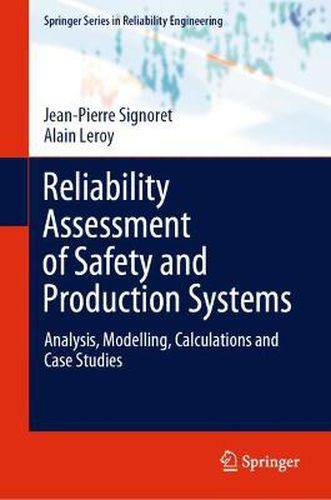Readings Newsletter
Become a Readings Member to make your shopping experience even easier.
Sign in or sign up for free!
You’re not far away from qualifying for FREE standard shipping within Australia
You’ve qualified for FREE standard shipping within Australia
The cart is loading…






This title is printed to order. This book may have been self-published. If so, we cannot guarantee the quality of the content. In the main most books will have gone through the editing process however some may not. We therefore suggest that you be aware of this before ordering this book. If in doubt check either the author or publisher’s details as we are unable to accept any returns unless they are faulty. Please contact us if you have any questions.
This book provides, as simply as possible, sound foundations for an in-depth understanding of reliability engineering with regard to qualitative analysis, modelling, and probabilistic calculations of safety and production systems.
Drawing on the authors’ extensive experience within the field of reliability engineering, it addresses and discusses a variety of topics, including:
*
Background and overview of safety and dependability studies;
*
Explanation and critical analysis of definitions related to core concepts;
*
Risk identification through qualitative approaches (preliminary hazard analysis, HAZOP, FMECA, etc.);
*
Modelling of industrial systems through static (fault tree, reliability block diagram), sequential (cause-consequence diagrams, event trees, LOPA, bowtie), and dynamic (Markov graphs, Petri nets) approaches;
*
Probabilistic calculations through state-of-the-art analytical or Monte Carlo simulation techniques;
*
Analysis, modelling, and calculations of common cause failure and uncertainties;
*
Linkages and combinations between the various modelling and calculation approaches;
*
Reliability data collection and standardization.
The book features illustrations, explanations, examples, and exercises to help readers gain a detailed understanding of the topic and implement it into their own work. Further, it analyses the production availability of production systems and the functional safety of safety systems (SIL calculations), showcasing specific applications of the general theory discussed. Given its scope, this book is a valuable resource for engineers, software designers, standard developers, professors, and students.
$9.00 standard shipping within Australia
FREE standard shipping within Australia for orders over $100.00
Express & International shipping calculated at checkout
This title is printed to order. This book may have been self-published. If so, we cannot guarantee the quality of the content. In the main most books will have gone through the editing process however some may not. We therefore suggest that you be aware of this before ordering this book. If in doubt check either the author or publisher’s details as we are unable to accept any returns unless they are faulty. Please contact us if you have any questions.
This book provides, as simply as possible, sound foundations for an in-depth understanding of reliability engineering with regard to qualitative analysis, modelling, and probabilistic calculations of safety and production systems.
Drawing on the authors’ extensive experience within the field of reliability engineering, it addresses and discusses a variety of topics, including:
*
Background and overview of safety and dependability studies;
*
Explanation and critical analysis of definitions related to core concepts;
*
Risk identification through qualitative approaches (preliminary hazard analysis, HAZOP, FMECA, etc.);
*
Modelling of industrial systems through static (fault tree, reliability block diagram), sequential (cause-consequence diagrams, event trees, LOPA, bowtie), and dynamic (Markov graphs, Petri nets) approaches;
*
Probabilistic calculations through state-of-the-art analytical or Monte Carlo simulation techniques;
*
Analysis, modelling, and calculations of common cause failure and uncertainties;
*
Linkages and combinations between the various modelling and calculation approaches;
*
Reliability data collection and standardization.
The book features illustrations, explanations, examples, and exercises to help readers gain a detailed understanding of the topic and implement it into their own work. Further, it analyses the production availability of production systems and the functional safety of safety systems (SIL calculations), showcasing specific applications of the general theory discussed. Given its scope, this book is a valuable resource for engineers, software designers, standard developers, professors, and students.